A 40kg slab rests on a frictionless floor. A 10kg block rests on top of the slab. the static coefficient of friction between the block and the slab is 0.60 and The coefficient kinetic friction between the block and the slab is 0.40. A horizontal force of 100N is applied on the 10kg block. Find the resulting acceleration of the slab. (g=10ms−1)
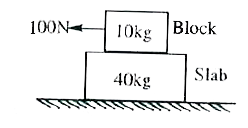 Solution in Telugu
Solution in Telugu
3ms−2
4ms−2
1ms−2
2ms−2
The correct Answer is:C
Step by step video & image solution for A 40kg slab rests on a frictionless floor. A 10kg block rests on top of the slab. the static coefficient of friction between the block and the slab is 0.60 and The coefficient kinetic friction between the block and the slab is 0.40. A horizontal force of 100N is applied on the 10kg block. Find the resulting acceleration of the slab. (g=10ms^(-1)) by Physics experts to help you in doubts & scoring excellent marks in Class 11 exams.
Topper's Solved these Questions
- BOOK - AAKASH SERIESCHAPTER - FRICTION EXERCISE - LECTURE SHEET EXERCISE- IV (LINKED COMPREHENSION TYPE QUESTIONS)3videos
FRICTION
- BOOK - AAKASH SERIESCHAPTER - FRICTION EXERCISE - LECTURE SHEET EXERCISE- IV (INTEGER TYPE QUESTIONS)1videos
FRICTION
- BOOK - AAKASH SERIESCHAPTER - FRICTION EXERCISE - LECTURE SHEET EXERCISE- III (INTEGER TYPE QUESTIONS)2videos
FRICTION
- BOOK - AAKASH SERIESCHAPTER - FLUID MECHANICSEXERCISE - Questions for Descriptive Answers14videos
FLUID MECHANICS
- BOOK - AAKASH SERIESCHAPTER - GAUSS.S LAW EXERCISE - PROBLEMS (LEVEL - II)12videos
GAUSS.S LAW
Similar Questions
Block A of mass 35kg is resting on a frictionless floor. Another block B of mass 7kg is resting on it as shown in the figure. The coefficient of friction between the blocks is 0.5 while kinetic friction is 0.4.(g=10ms−2)
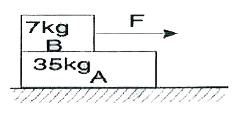
In the above question what will be the acceleration of the system?05:38View SolutionIn the figure, m1m2=1kg, The co-efficients of friction between A, B and B, surface are 0.2. The maximum value of m, so that no block slips is nx7 the value of n is (All the pullies are ideal and strings are massless).
 03:08View Solution
03:08View SolutionA wedge of mass 2m and a cube of mass m are shown in figure. Between cube and wedge, there is no friction. The minimum coefficient of friction between wedge and ground so that wedge does not move is 2×10−x where x is
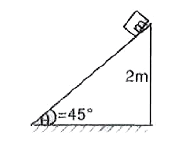 06:50View Solution
06:50View SolutionA U-tube of base length I filled with same volume of two liquids of densities ρ and 2ρ is moving with an acceleration a on the horizontal plane. If the height difference between the two surfaces (open to atmosphere)becomes zero,then find height h
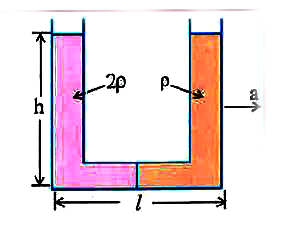 04:26View Solution
04:26View SolutionA charge q is placed at the centre of the open end of a cyclindrical vessel. Find the flux of the electric through the surface of the vessel.
09:24View SolutionA large slab of mass 5kg lies on a smooth horizontal surface, with a block of mass 4kg lying on the top of it. The coefficient of friction between the block and the slab is 0.25. If the block is pulled horizontally by a force of F =6N, the work done by the force of friction on the slab, between the instants t=2s and t=3s, is (g=10ms−2)
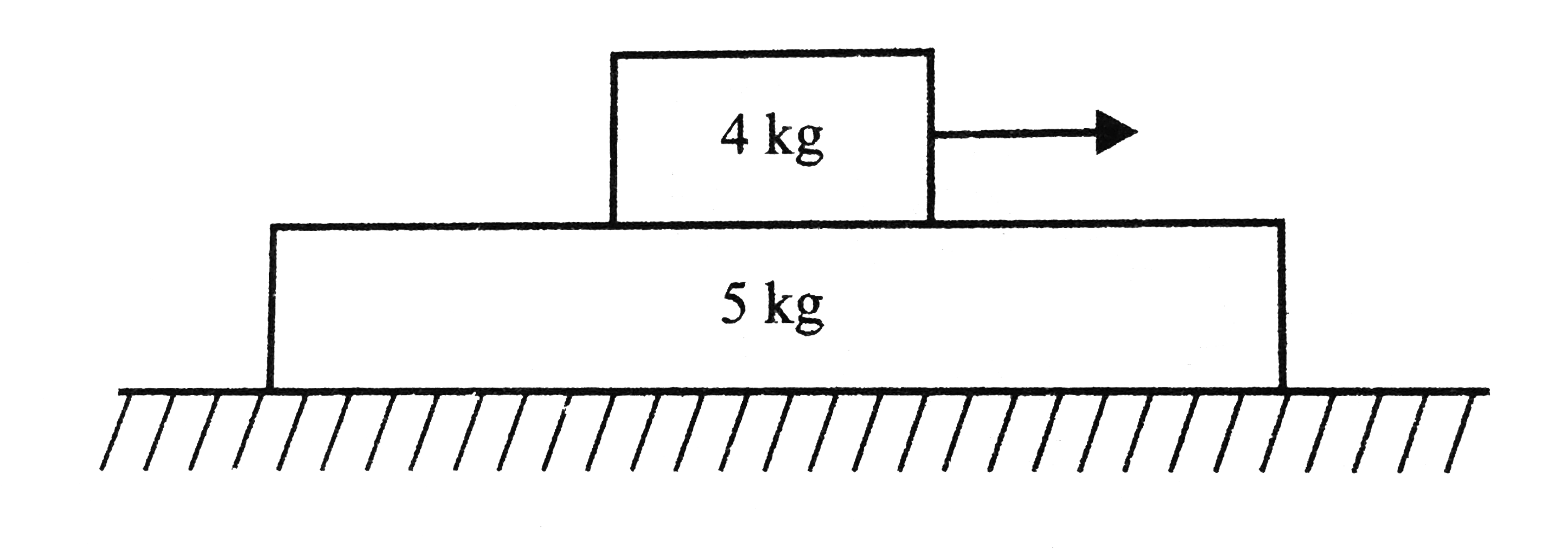 03:01View Solution
03:01View SolutionA 40 kg slb rest on a frictionless floor as shown in the figure. A 10 kg block rests on the top of the slab. The static corfficient of friction between the block and slab is 0.60 while the kinetic friction is 0.40 the 10 kg block is acted upon by a horizontal force 100N. If g=9.8(m)/(s^2) , the resulting acceleration of the slab will be.
02:30View SolutionA 40kg slab rests on a frictionless floor as shown in the figure. A 10kg block rests on the top of the slab. The static coefficient of friction between the block and slab is 0.60 while the kinetic friction is 0.04 . The 10kg block is acted upon by a horizontal force 100N. if g=9.8m//s^(2) , the resulting acceleration of the slab will be.
03:16View SolutionA slab of 40kg lying on a frictionales floor and a block of 10 kg rests on the slab as shown in the figure. The coefficients of static and kinetic friction between the slab and the block are 0.6 and 0.4 respectively. If a force of 100N is applied on the block, then the acceleration the slab will be (g=10m/s2)
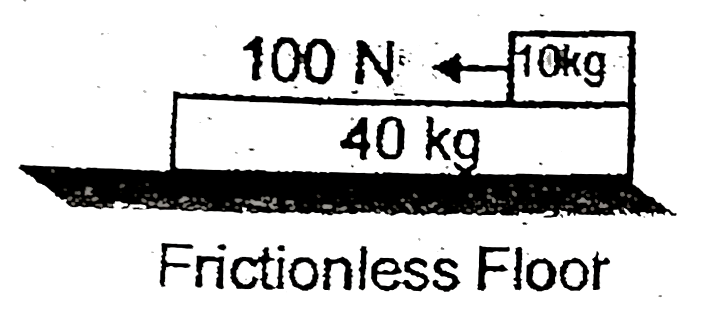 02:35View Solution
02:35View SolutionA 40 kg slab rests on a frictionless floor . A 10 kg block rests on the top of the slab . [Fig. 7.81 (a)] . The coefficients of static and dynamic friction are 0.60 and 0.40 respectively . The 10 kg block is pulled by a horizontal force of 100 N . what are the resulting accelerations of (a) the block (b) the slab ? ( g = 10 m// s^(2) )
View SolutionA 40 kg slab rests on a frictionless floor . A 10 kg block rests on top of the slab (Fig . 7. 121). The static coefficient of friction between the block and the slab is 0.60 while the kinetic coefficient is 0.40 . The 10 kg block is acted upon by a horizontal force of 100 N . if g = 9.8 m//s^(2) the resulting acceleration of the slab will be :
05:39View SolutionIf 100N force is applied to 10kg. block as shown in diagram then acceleration produced for slab-
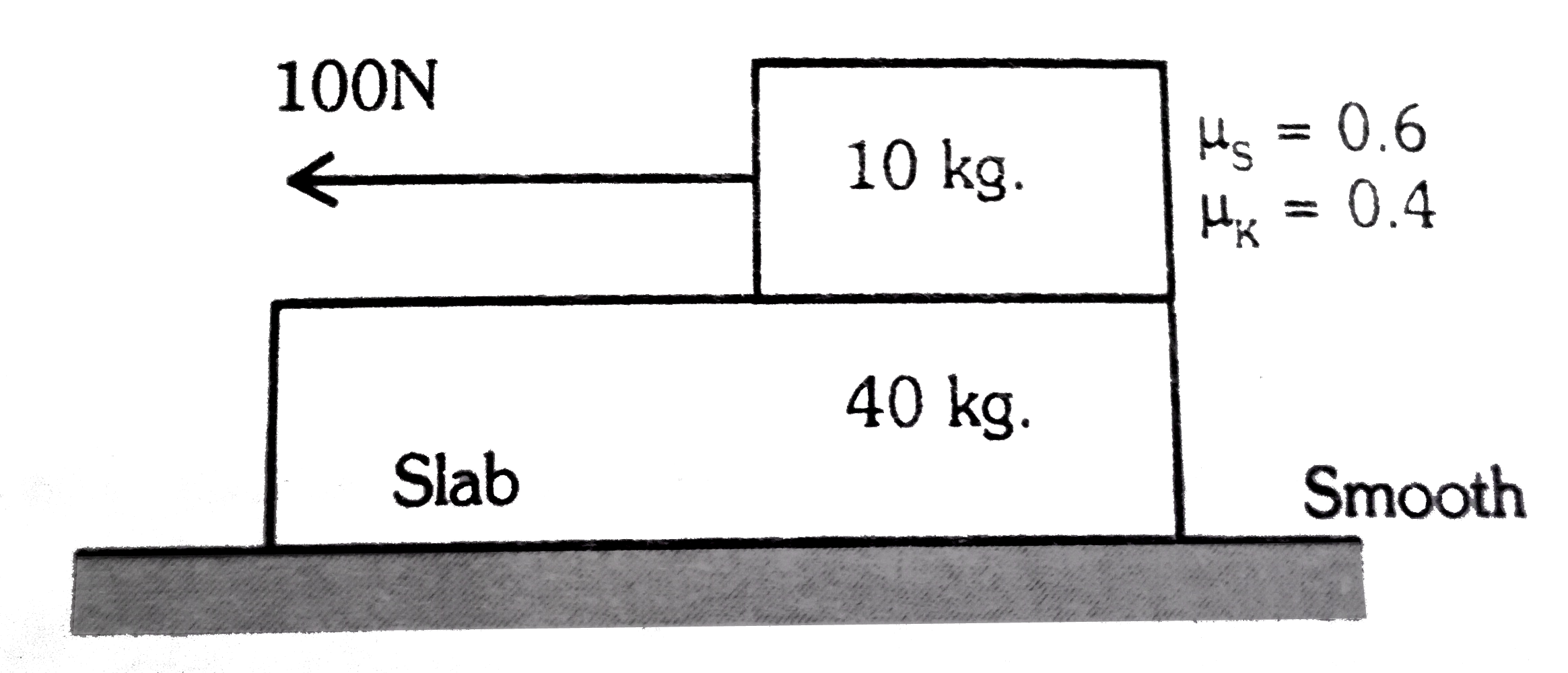 04:18View Solution
04:18View SolutionA block on a horizontal slab is moving horizontally with a simple harmonic motion of frequency two oscillations per second. If the coefficient of static friction between block and slab is 0.5, then the amplitude of the oscillation will be (if the block does not slip along the slab)
04:56View SolutionA 40 kg slab rests on a frictionless floor. A 10 kg block rests on top of the slab. The coefficient of friction between the block and the slab is 0.40. The 10 kg block is acted upon by a horizontal force of 100 N. If g=10m/s2, the resulting acceleration of the slab will be
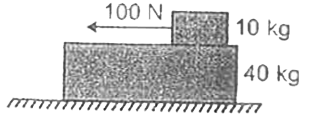 05:21View Solution
05:21View SolutionIn Fig. 6-54, a slab of mass m1=40 kg rests on a frictionless floor, and a block of mass m2=12 kg rests on top of the slab. Between block and slab, the coefficient of static friction is 0.60, and the coefficient of kinetic friction is 0.40. A horizontal force →F of magnitude 120 N begins to pull directly on the block, as shown. In unit-vector notation, what are the resulting accelerations of (a) the block and (b) the slab?
 02:50View Solution
02:50View Solution

